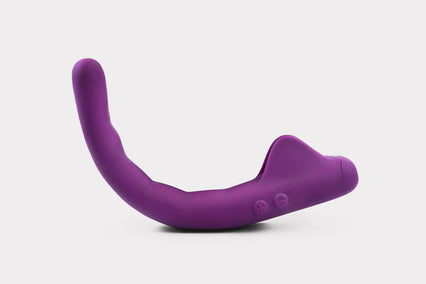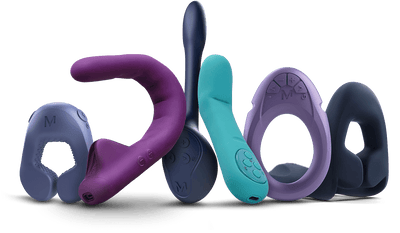Living with endometriosis often means navigating a maze where intimate moments can shift from delightful to daunting. Endometriosis pain might present a hurdle to your sex life, but it doesn’t have to halt it completely. One thing that can make a big difference during intimacy is lubrication – and the right lubrication. Finding the best lube for endometriosis goes beyond just comfort - it's about reclaiming your power and pleasure. Let's explore how lubrication can improve your sexual health, what features to look for, and review the best options for those with endometriosis, including CBD-infused varieties and different formulas like water, oil, and silicone-based.
Why does lubricant for endometriosis matter?
Endometriosis can cause discomfort during sex due to vaginal dryness, which can be caused by arousal issues from pain, or side effects from hormonal therapies to treat the condition. Adhesions or scar tissue from endometriosis can make things even more uncomfortable, causing pelvic pain. This can lead to painful stretching and sensations during penetration, which might explain why many women experience painful sex.
Using lubricant can help reduce friction and pain, making things smoother and more enjoyable. Lubricant can help alleviate the side effects of vaginal dryness from hormonal issues, and helps offset the arousal issues and lack of natural lubrication you may experience from endometriosis pain.
Best lubricants for endometriosis
Picking the right lube for endometriosis can feel overwhelming. With so many options for personal lubricants, finding the one that improves your intimacy can feel like searching for a needle in a haystack. Let’s simplify your search with this list of top-rated lubricants for endometriosis.
CBD lube for endometriosis
CBD lube is a promising option for women with endometriosis. It can help relax pelvic muscles, increase blood flow, and potentially improve comfort during sex. It's worth noting that some individuals may experience allergic reactions or skin irritation using CBD lube.
Foria
Foria's CBD-infused lubricant, a coconut oil-based formula, is known for its soothing and moisturizing properties.
Kush Queen
Kush Queen makes a water-based CBD lube that's compatible with latex condoms and sex toys. It's a versatile option for anyone wanting to explore the potential benefits of CBD.
Water-based lubricants
Water-based lubricants are popular because they feel most like natural lubrication, are easy to use, and work well with different products. They are usually made with ingredients that support the vaginal microbiome without disrupting pH levels.
Pjur Aqua
Pjur Aqua is a great water-based formula that is fragrance-free, oil-free, and flavor-free, and is safe for daily use and compatible with condoms and sex toys.
Good Clean Love
Good Clean Love is a water-based lube worth considering. It's got aloe vera for extra moisture, and it doesn't contain questionable ingredients.
Slippery Stuff
Slippery Stuff offers a gel-based option that doesn't dry out too quickly. While its pH may be higher, its osmolality and ingredients are considered safe.
Yes Lubricants
Yes lubricants are water-based lubes that are organic and free of glycerin and glycols. If you're trying to conceive, give their Yes Baby Sperm-Friendly Lube a go.
Desert Harvest
Desert Harvest's Aloe Glide is a natural lube made with aloe vera. It's free from harmful additives and has low osmolality. Plus, it's safe to use with latex or polyisoprene condoms.
Aloe Cadabra
Aloe Cadabra makes an aloe-based lubricant that's gentle and safe for most users, even for those with sensitivities.
Oil-based lubricants
Oil-based lubricants are known for their long-lasting and moisturizing properties. They are an excellent option for people who need or prefer long-lasting lubrication. However, oil-based products can break down latex condoms and other latex items. Additionally, some individuals may find that natural oils can contribute to yeast infections.
Coconut oil
Coconut oil is a versatile and natural lubricant that provides long-lasting lubrication. Many lubricants contain coconut oil for this reason. It can be used alone as a personal moisturizer. Pure, unrefined organic coconut oil is the best option if going this route.
Silicone-based lubricants
Silicone-based lubricants offer a super slippery texture and work great with latex condoms. They have a thicker consistency that provides longer-lasting lubrication than water-based lubes, making them perfect for anyone who wants extended lubrication. Just keep in mind that they can be a bit tough to wash off, so make sure to use soap and water for proper cleaning. Also, avoid using silicone-based lubes with silicone toys, as they can degrade their material.
Pjur Silicone
Pjur makes silicone-based lubes too. Known for its long-lasting lubrication that's compatible with latex or polyisoprene condoms.
Uberlube
Uberlube offers long-lasting lubrication, providing a comfortable experience without constant reapplication. It's compatible with latex or polyisoprene condoms.
Probe
Probe has lubricant that's low osmolality profile is designed to mimic the body's natural lubrication. So, you get a smooth, effective, and natural feel without sacrificing safety.
What features to look for in lube for endometriosis
Choosing the right lubricant is important for helping with endometriosis and pelvic discomfort. However, it can be a slippery slope, as many lubricants can disrupt your vaginal microbiome. You want to avoid extra irritation and maintain a healthy vaginal and rectal microbiome with whichever lubricants you use. Here are some features to look out for when choosing a lubricant for endometriosis.
Select lubes with low pH
When choosing a lubricant, pH levels play a crucial role. A healthy vagina typically has a pH range of 3.8 to 5.0, and maintaining this balance prevents bacterial disruptions and infections. So, you want to use a lubricant that syncs with your body’s natural pH. According to the World Health Organization, a vaginal lubricant should have a pH of about 4.5.
Opt for lubes with low osmolality
Osmolality is another important factor to consider. It refers to the concentration of dissolved particles in the product. Basically, lubricants with high osmolality can draw moisture out of the vagina, which can increase irritation or further discomfort. The World Health Organization (WHO) recommends using lubricants with low osmolalities less than 1200 mOsm/kg, ideally less than 380 mOsm/kg or even lower, to avoid potential irritation and tissue damage. These levels are similar to the normal osmolality of female vaginal tissue.
Avoid lubes with irritating additives
Make sure to carefully go through the list of ingredients for any irritants or harmful additives. When it comes to lubricants, go for scent-free, glycerin-free, paraben-free, and petroleum-free options for safety and comfort. Pay close attention to these ingredients:
Glycols
Glycols, which help maintain moisture, can increase the risk of bacterial vaginosis and yeast infections if present in high amounts.
Glycerol / glycerin
Glycerol, also known as glycerin, is found in many mainstream lubricants, can get sticky and potentially contribute to yeast overgrowth and urinary tract infections (UTIs) when used in high concentrations. It could also potentially increase vulnerability to sexually transmitted infections (STIs) and HIV when used at certain concentrations.
Parabens
Parabens, which are used as preservatives, can mimic estrogen and potentially disrupt hormone function in both men and women. However, more research is needed to understand the implications fully.
Nonoxynol-9
Some compounds in lubricants can harm the body's natural defenses. For instance, nonoxynol-9 is added for its spermicidal properties, but it can damage the lining of the vagina, disrupting the vaginal pH.
Chlorhexidine gluconate, cyclomethicone, cyclopentasiloxane, and cyclotetrasiloxane
Chlorhexidine gluconate and certain silicones like cyclomethicone, cyclopentasiloxane, and cyclotetrasiloxane have been associated with some serious health risks; these include increased susceptibility to chlamydia and potential links to uterine cancer and reproductive harm.
Check the compatibility with condoms
If you plan on using condoms during intimacy, specifically latex condoms, be aware that some lubes can break down the latex in condoms, which increases the risk of condom breakage. Make sure the lube you choose is compatible with your condoms.
Tips for endometriosis and sex
Here are some tips for using lube when dealing with endometriosis:
- Avoid using fragranced or harsh lubes, as they can irritate sensitive genital tissues and make endometriosis symptoms worse.
- Give different lubes a try to find what works best for you. If a lubricant causes discomfort like stinging, soreness, or pelvic pain, try a different product to see if it helps.
- To make pelvic exams more comfortable for those with endometriosis, using lube on the vaginal opening and speculum can help ease discomfort.
In addition to using lube, taking care of yourself is crucial when managing endometriosis. This includes:
- Try out relaxation techniques to manage stress and anxiety associated with painful sex, like meditation or yoga.
- Listen to your body. Pay attention to its signals and rest when needed. Pushing yourself too hard can cause more pain and discomfort.
- Consider non-penetrative sex options like outercourse, oral sex, or using external vibrators like Legato, which can promote natural lubrication and arousal without the need for internal penetration.
- Consider pelvic floor therapy and therapeutic products that help with pelvic pain like pelvic wands or the doctor-recommended vibrator Crescendo 2 that is clinically proven to help with pelvic pain and arousal issues.
- Experiment with various sex positions and rhythms during intercourse to ease any discomfort. Sometimes, the best sex positions for endometriosis deemphasize deep penetration positions that may cause pain in women with endometriosis.
- Always consult a healthcare provider before making changes to self-care practices, ensuring that any interventions are safe and tailored to your health needs.
Takeaway
Intimacy while living with endometriosis can be a challenge, but lubricant is one beacon of hope that goes beyond reducing friction. The right lubricant can transform your sexual experience, providing comfort and enhancing your sex life. With this list of the best lube for endometriosis that prioritizes both safety and pleasure, self-care practices like meditation, and trying different sex positions, pleasure is within your power. If you're looking to address pelvic pain or arousal issues, the clinically proven medical vibrator Crescendo 2 is worth considering as your next option for improving sexual pleasure and health.















































